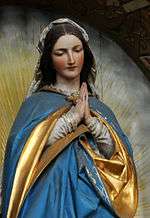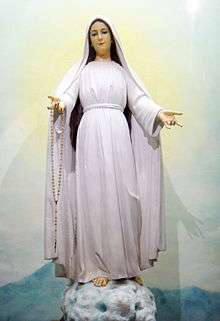Mediatrix of all graces
| Part of a series on the |
| Mariology of the Catholic Church |
|---|
 Virgo by Josef Moroder-Lusenberg |
|
|
|
|
|
Mediatrix of all graces is a title that Roman Catholics give to the Blessed Virgin Mary as the Mother of God; it includes the understanding that she mediates the Divine Grace. In a papal encyclical of Sept. 8, 1894 Pope Leo XIII states the following:
"The recourse we have to Mary in prayer follows upon the office she continuously fills by the side of the throne of God as Mediatrix of Divine grace"[1]
— Pope Leo XIII, Iucunda Semper Expectatione
The Second Vatican Council referred in its document Lumen gentium to Mary as "Advocate, Auxiliatrix, Adjutrix and Mediatrix".
Proposal for dogmatic definition
The formal definition of Mediatrix of all graces as a dogma was not considered opportune during discussions held to prepare for the Second Vatican Council.[2]
In 1896, French Jesuit priest René-Marie de la Broise interpreted Pope Leo XIII's papal encyclical Octobri mense[3] as teaching that all graces from Jesus Christ are imparted through Mary. Broise proposed that the pontiff should make a dogmatic definition about the role of Mary in the distribution of all graces, but did not require that it be in the form of declaring her to be the mediatrix of all graces.[4]
Celebration in Belgium
In Belgium, 8 years later, Redemptorist priest François Xavier Godts wrote a book, De definibilitate mediationis universalis Deiparae (On the definability of the universal mediation of the Mother of God), proposing precisely that it be defined that Mary is the Mediatrix of all graces. Désiré-Joseph Mercier, Cardinal Archbishop of Mechelen, Belgium championed this cause.
In response to petitions from Belgium, including one signed by all its bishops, the Holy See approved in 1921 an annual celebration in that country of a feast day of Mary Mediatrix of All Graces.[5] In printings of the Roman Missal from that date until 1961, the Mass of Mary Mediatrix of All Graces was found in the appendix Missae pro aliquibus locis (Masses for Some Places), but not in the general calendar for use wherever the Roman Rite is celebrated.[6] Other Masses authorized for celebration in different places on the same day 31 May were those of the Blessed Virgin Mary Queen of All Saints and Mother of Fair Love and Our Lady of the Sacred Heart of Jesus. The Belgian celebration has now been replaced by an optional memorial on 31 August of the Virgin Mary Mediatrix.[7]
Scholarly opposition to dogmatic definition
Despite requests for a new Marian dogma, the Fathers of Vatican II and the Popes who presided at the Council, John XXIII and Paul VI decided not to proceed with new dogmatic definitions. The decree Lumen gentium of Vatican II would caution of the title of "Mediatrix" that: "This, however, is to be so understood that it neither takes away from nor adds anything to the dignity and efficaciousness of Christ the one Mediator". Lumen gentium had 2,151 bishops voting for it and only five against.[8]
In August 1996, a Mariological Congress was held in Czestochowa, Poland, where a commission was established in response to a request of the Holy See. The congress sought the opinion of scholars present there regarding the possibility of proposing a fifth Marian dogma on Mary as Coredemptrix, Mediatrix and Advocate. The commission unanimously declared that it was not opportune to define a fifth Marian dogma on those titles. The Declaration of Czestochowa observed that while these titles can be given a content in conformity with the deposit of the faith, nevertheless such "titles, as proposed, are ambiguous, as they can be understood in very different ways".[2]
Devotion in the Philippines

Among Filipino Catholics, the term "Mediatrix" is associated with an alleged 1948 apparition of the Virgin Mary to Teresita Castillo, with title Our Lady Mediatrix of All Grace in the Carmelite monastery of Lipa, Batangas, Philippines. Ramón Argüelles, the current Archbishop of Lipa, declared his personal belief in the veracity of the 1948 apparitions, encouraging veneration of Mary under that title.[9]
The apparition is well known in the Philippines and among the Filipino diaspora, most notably the preserved rose petals which fell from the sky and are claimed to be miraculous. Philippine Ambassador to the Holy See Mercedes Arrastia Tuason is a known devotee of the apparitions, and displays a large statue in her consulate office in Rome.[10]
Stigmatist Emma de Guzman, foundress of the La Pieta association, which has received ecclesiastical approval,[11] said that Mary had declared herself to be "the Mediatrix standing in front of the Mediator".[12]
The term "Our Lady" with which the Celestial Queen and Virgin Mother shows herself in so many apparitions relies on her "setting role" near Jesus Christ God (and thus Lord and King) which is the guiding Shepherd,[13] the delivering Saviour,[14] the Last Judge.[15] In respect of the chronological order of this triplex role and function of Jesus, Mary may be titled and specified as the Mediatrix of grace, the Co-Redemptrix of salvation, the Advocate of justice.
Continued campaigning
Groups of laity and clergy, what has been called "a small but growing movement",[16] continue to operate for proclaiming the dogma of the universal mediation of Mary.[17] One such group calls itself Vox Populi Mariae Mediatrici.[18] On 8 February 2008, five cardinals published a petition asking Pope Benedict XVI to declare the Blessed Virgin Mary both Co-Redemptrix and Mediatrix, and over 500 bishops later added their signatures.[19] The magazine Inside the Vatican and Saint Thomas More College organized a one-day panel discussion on the question in Rome on 25 March 2010.[16]
That mariological mediation of any and the whole divine grace concerns the Divine Mercy as the early fruit of the Glory and Graces springing from the Sacred Heart of Jesus Christ God, in the kingdom of the Divine Will.[20]
Italian mystic Luisa Piccarreta (Corato, 1865-1947), also known as the "Daughter of the Divine Will, wrote an opus collected in a 36-volume entitled "The Book of Heaven". Luisa's writing on the Divine Will described hundreds of dated entries of the Blessed Virgin Mary. One of these epiphanic experiences revealed some personal details about the nativity of Jesus Christ God.
While in the Divine Will, Luisa saw Jesus after He come forth from the Maternal womb, fling himself into the arms of His Celestial Mother. Feeling the need to make His first outpouring of love, He surrounded the neck of His mother with his tiny arms, kissing her. His Virgin Mother also felt the need to pour out her love toward the Divine Infant. While contemplating the first outpouring of love between Mother and Son, Jesus told her about the great need He had to make this display of love with His Mother ([21] p. 156: [V27; 09/28/1929]). In the Virgin was centralized all the outpouring of love which the Divinity has made widespread[Note 1] in the Creation. Since the Divine Will was in her, she was capable of receiving, with the kisses of the Baby Jesus, this great outpouring, and of returning it to Him. One who lives in the Divine Will centralizes within herself the continous act of all Creation, and the attitude to puring it back to God ([21] p. 157: [V27; 09/28/1929]).
In other words, the Celestial Queen and Virgin Mother of God shows a central role of her mediation in making pure the love returned to God from humans, which are living in common and in perfect accord to the life of His Divine Will, and together with His earthly and heavenly Holy Family.
The Celestial Queen is Mother to Jesus according to the order of nature and she is also his Mother in the divine order, by virtue of the Divine Will she possessed. Had she not possessed his Will, she would not have been Mother to him in either order. In one who lets herself be dominated by the Divine Volition, the Fiat makes the divine order descend into the human and It converts the divine order into one's nature. It makes of her such portents as to astonish heaven and earth.
— Frank M. Rega, All what God is by nature, Mary is by grace, 2017[21] p. 164: [V29; 07/02/1931]
The Blessed Virgin Mary took care of everything and did everything to make Him happy, and redouble on the earth the heavenly Paradise he had left. Mary made Him enjoy her beauty and the beauty of her acts, shining of the Divine Will which she possessed: the beauty of her acts and the paradise of her love, braided the whole of Creation, so that He could find her everywhere, forming a Paradise for Him on earth ([21] p. 165: [V36; 12/25/1938]).
Notes
- ↑ in respect of the aforementioned book, the verb "had" is replaced by the expression "has made widespread", derived by the introductory context
References
- ↑ Pope Leo XIII, Encyclical Iucunda Semper Expectatione, 8 September 1894
- 1 2 L'Osservatore Romano, Weekly Edition in English 25 June 1997, page 10
- ↑ Pope Leo XIII, Encyclical Octobri mense, 22 September 1891; cf. William G. Most, "Church Teaching on Mary as Mediatrix of (All) Graces"
- ↑ Gloria Falcão Dodd, The Virgin Mary, Mediatrix of All Graces: History and Theology of the Movement for a Dogmatic Definition from 1896 - 1964 (Academy of the Immaculate. 2012. ISBN 978-1-60114061-6), pp. 51–52
- ↑ Mark Miravilla (editor), 2008, Mariology: A Guide for Priests, Deacons, Seminarians, and Consecrated Persons, Queenship Publishing. ISBN 1-57918-355-7. page 448.
- ↑ See, for instance, the 1957 printing and a late-1920s printing.
- ↑ Calendrier liturgique francophone 2010-2011
- ↑ "Lumen gentium, 62". www.vatican.va. Retrieved 2017-12-20.
- ↑ Letter of Archbishop Ramon C. Arguelles, 17 April 2005
- ↑ Office of the Ambassador of the Philippines to the Vatican, Pope Paul VI residence - https://www.youtube.com/watch?v=c4uNvPfw2lk
- ↑ /Catholic Bishops' Conference of the Philippines, Endorsement of pilgrimage, 1 August 2007
- ↑ June Keithley Castro, "Messages from Mama Mary" in Philippine Daily Inquirer, 16 September 2012
- ↑ "The Lord is my shepherd" in Psalm 23:1-3
- ↑ "Refuge in the delivering Saviour" in Psalm 7:11-14
- ↑ "The Last Judge" in Psalm 94:1
- 1 2 Robert Moynihan, "Is the Time Ripe for a 5th Marian Dogma?" in ZENIT, 1 March 2010 Archived 3 May 2012 at the Wayback Machine.
- ↑ Mark Miravalle, 1993, Introduction to Mary. Queenship Publishing. ISBN 978-1-882972-06-7 page 51
- ↑ "Voice of the People for Mary Mediatrix". Retrieved 2008-10-09.
- ↑ "ZENIT - Cardinals' Letter Promoting Marian Dogma". Archived from the original on 2008-09-17. Retrieved 2008-10-09.
- ↑ "Feast of the Sacred Hearth of Jesus in the Kingdom of the Divine Will". November 28, 1920. Archived from the original on September 14, 2013.
- 1 2 3 4 Rega (OFS), Frank M. (Jun 17, 2017). All what God is by nature, Mary is by grace. Poland. pp. 156–165. ISBN 978-1-548-25110-9. A compendium on the Blessed Virgin Mary, found in the 36-volume collection of writings of Luisa Piccarreta, called "Book of Heaven".
External links
| Wikimedia Commons has media related to Mediatrix of all graces. |